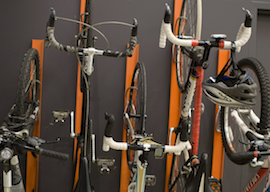Answer: Shipping DVDs
Context
Membership models that allow users to access things like music, cars, and TV on-demand are a growing phenomenon. One of the most mainstream examples is Netflix, where movies and shows are watched on DVD or streamed directly online. But with a growing trend towards mobile and dematerialized experiences, the DVD option seems like it is growing obsolete. While streaming seems like the way of the future, we wondered how the comparison holds up on a sustainability level. We compared shipping a DVD and streaming a movie to see which is the greener choice.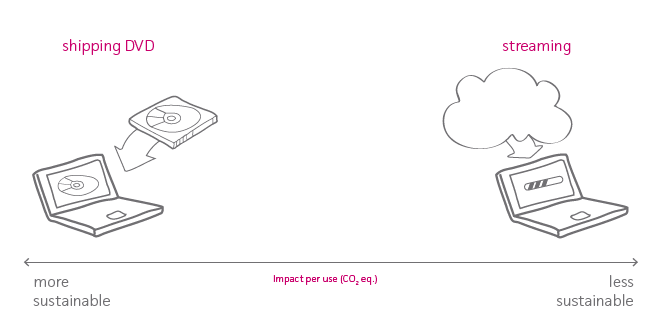
How We Measured It
Our metric for comparison is the carbon dioxide equivalent (CO2 eq.) emissions resulting from the delivery and viewing of one movie by the “average American”—someone who has internet access and a DVD player (you’ll see later why these details are important). The full life cycle is considered: materials, manufacturing, transportation, use, and end-of-life.
Our answer (shipping DVDs) may be surprising for many reasons. One of them is that, while our answer is based on the thorough analysis and calculations of a study, our conclusion is different. The study says streaming is better, but only because it compares it to the overall results of all DVD options grouped together (mail shipment, and driving to a store to rent or buy one). When we look at DVD shipments alone, our findings show that DVDs have almost half the impact of streaming! Here’s why:
Delivering your movie (transportation)
While it may seem counter-intuitive to think that shipping a metallic disk all over the place in a truck is more efficient than sending a movie file electronically through “the tubes,” shipping is actually significantly more efficient than streaming. This is a classic case of mistakenly focusing only on what we see.
It’s nice to imagine the Cloud or the Internet as a vaporous, immaterial space with which we can freely store and access our favorite stuff. The reality is that it takes energy to push digital bits through the tubes. Because all those movies and addictive TV shows we stream are huge files, streaming them takes more energy than you might expect. In fact, just streaming a movie has several times the impact of manufacturing and shipping it on a DVD.
Why? Because when it comes to shipping DVDs by truck, your movie is but a fraction of the weight and volume of a fully loaded shipping vehicle. By carrying many packages on a single, efficient delivery route, a shipping vehicle greatly reduces the impact resulting from any one package. Note that the story is completely different if you drive to a local DVD rental store or kiosk. As discussed in “Paper Books vs. E-Books”, burning a single gallon of gasoline in your car emits about 9 kg of CO2, meaning your two round-trip drives to the rental store or kiosk 3 miles away (one to borrow, one to return) will have several times the impact of delivery by streaming.
The original study (without consideration of idling DVD players in the streaming case):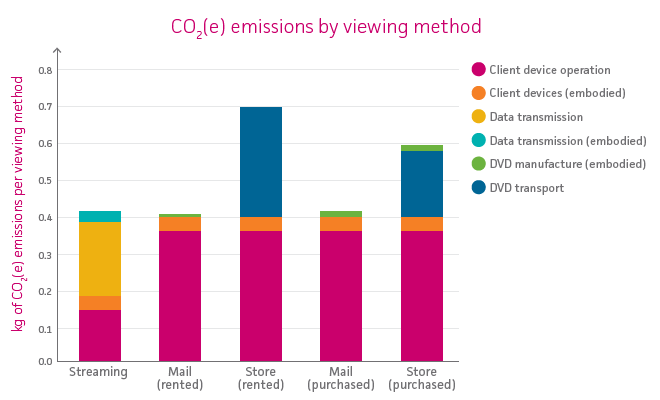
Watching your movie (use)
Another difference we found from the study resulted from a difference in our context for evaluation. When it comes to the viewing phase, it turns out that the DVD player is the secret villain. The sole purpose of a DVD player is to play DVDs, meaning that all of the energy it uses should be attributed to movie-watching. DVD players use energy even when they aren’t playing a movie. In fact, most DVD players consume only slightly less power when idling than when playing a DVD: 13W vs. 17W. (When off, a DVD player consumes about 3W of power, but they are frequently left idle instead.)
While the study includes the energy used by an idle DVD player in the impact for watching DVDs, it doesn’t include the DVD player in its calculation of the impact of streaming. And why should it, you ask? After all, a DVD player is not used when streaming a movie. This is why context, and considering the average American, is key: most Americans who stream movies also own a DVD player (in 2013, 80% of U.S. households owned a DVD or Blu-ray player). Even if that DVD player is rarely used in a household that usually streams movies, its small but consistent energy draw if left idle for much of the year should be included in the streaming calculation because it is a significant contributor to the impact of that household’s in-home movie watching system. And that detail changes everything: including the idle DVD player in the streaming calculation increases its impact by a factor of 3!
While this conclusion is only valid for the average American, who owns a DVD player and keeps it idle, the takeaway from this behavioral nuance is simple: turning off (or, better yet, unplugging) your DVD player when not in use decreases the impact of your movie-watching habits by a monstrous 60%.
Considering DVD players are often left idle when not in use:
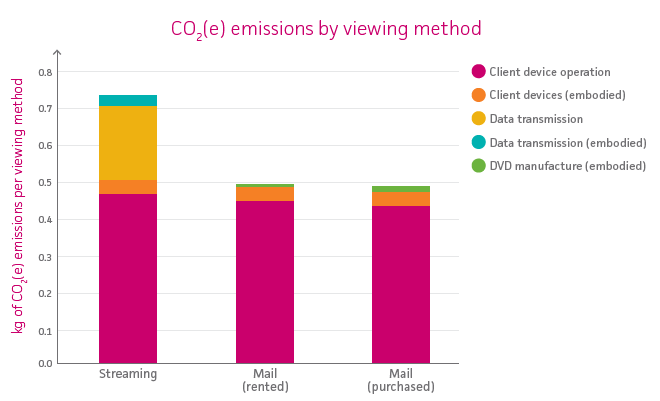
The experience
But what about the experience? Even if the carbon footprint of streaming movies is higher than that of shipping disks, DVDs are almost a thing of the past—for good reason. Who wants to wait days for movie night? And does your new laptop even have a disk drive? Streaming is convenient and instantaneous, and it fits well into people’s increasingly dematerialized lives. So how can we make the best of it?
At home, it’s all about your devices. The smallest change you can make with the most impact is to turn off or unplug your DVD player when not in use, regardless of whether or not you stream.
If DVD players are turned off when not in use: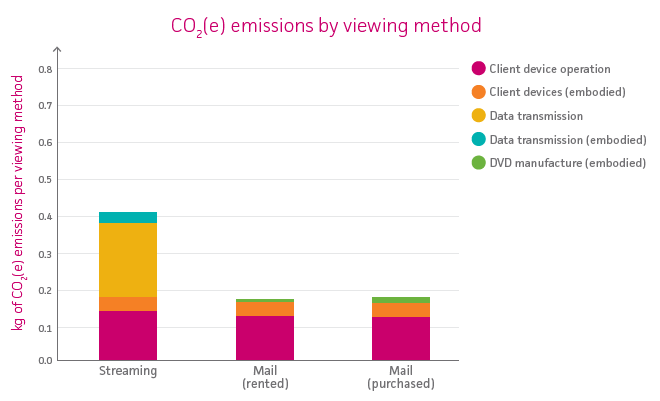
And there’s an easy way to reduce your streaming guilt: grab your tablet or laptop, or watch on your 20” LCD TV. Watching a movie on these devices uses between 5% and 30% of the energy needed to stream the movie to you. That 55” plasma screen TV is another story, requiring several times the energy than the romcom you were streaming to it. Use a smaller device screen—you’ll reduce your impact without sacrificing the convenience of streaming.
Implications
Many industries are evolving their offering from tangible products to dematerialized services. While convenience and speed are clear winners for users, invisible services don’t always mean green. The energy required behind the scenes and the legacy devices they leave behind can tip the environmental scale. By offering device recycling programs, including features like auto shut-off, and updating their energy-use model as they update their service model, companies who account for new user behaviors prove that progress can be a win-win.
Sources
http://iopscience.iop.org/1748-9326/9/5/054007/pdf/1748-9326_9_5_054007.pdf
http://iopscience.iop.org/1748-9326/9/5/054007/media/erl487799suppdata.pdf
http://none.cs.umass.edu/papers/pdf/green07q-seetharam.pdf
http://www.gallup.com/poll/166745/americans-tech-tastes-change-times.aspx
http://www.salon.com/2013/08/19/your_netflix_habit_uses_more_energy_than_your_fridge/
http://www.tv.com/news/tv-power-consumption-guide-3153/
http://www.cnet.com/news/power-consumption-how-much-are-your-gadgets-costing-you/



